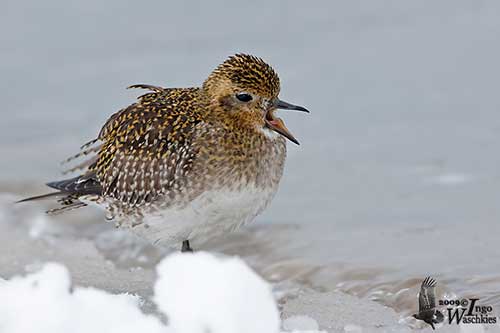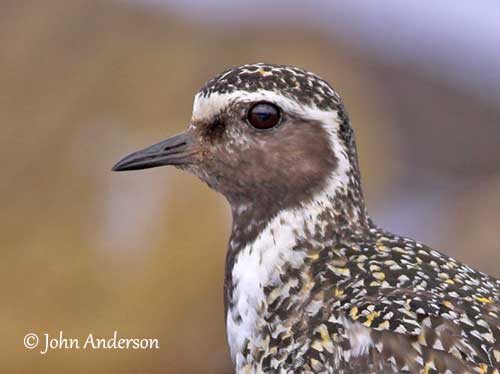
Fr: Pluvier doré
Ang: European or Eurasian Golden Plover
All: Goldregenpfeifer
Esp: Chorlito Dorado Europeo
Ita: Piviere dorato
Nd: Goudplevier
Sd: ljungpipare
Photographers:
John Anderson
John Anderson Photo Galleries
Jean Michel Fenerole
Photos d’Oiseaux du monde
Steve Garvie
RAINBIRDER Photo galleries & Flickr Rainbirder
Ingo Waschkies
Bird Photography
Text by Nicole Bouglouan
Sources:
HANDBOOK OF THE BIRDS OF THE WORLD Vol 3 by Josep del Hoyo-Andrew Elliott-Jordi Sargatal - Lynx Edicions - ISBN: 8487334202
SHOREBIRDS by Peter Hayman, John Marchant and Tony Prater – Christopher Helm – 1986 – ISBN: 0747014035
THE COMPLETE BOOK OF BRITISH BIRDS – Written by “Royal Society for the Protection of Birds” experts - Préface de Magnus Magnusson - Michael Cady- Rob Hume Editors - ISBN: 0749509112
THE HANDBOOK OF BIRD IDENTIFICATION FOR EUROPE AND THE WESTERN PALEARCTIC by Mark Beaman, Steve Madge - C. Helm - ISBN: 0713639601
ENCYCLOPEDIE DES OISEAUX DE FRANCE ET D’EUROPE – de Peter Hayman et Rob Hume - Flammarion – ISBN : 2082009920
GUIDE DES LIMICOLES de D. Taylor - Delachaux et Niestlé - ISBN : 2603014080
What Bird-The ultimate Bird Guide (Mitchell Waite)
SORA Searchable Ornithological Research Archive (Blair O. Wolf)
Arthur Grosset's Birds (Arthur Grosset)
Northern Ireland Priority Species
Journal of Avian Biology
Individual migration patterns of Eurasian golden plovers Pluvialis apricaria breeding in Swedish Lapland; examples of cold spell-induced winter movements
European or Eurasian Golden Plover
Pluvialis apricaria
Charadriiformes Order – Charadriidae Family
INTRODUCTION:
The European Golden Plover is a medium-sized wader, with rather compact body and short bill. It breeds in boreal and arctic areas from Iceland, through Great Britain and Scandinavia, E to W Siberia.
Two races shares this wide range, the southern is the nominate race, whereas the race “altifrons” is the northern subspecies. They show great variation in breeding plumage. They breed in a variety of grassland and heathland habitats, and winter along the W coasts of Europe and North Africa.
The European Golden Plover is not currently threatened, in spite of hunting pressure on its wintering grounds, especially in France.

DESCRIPTION OF THE BIRD:
Biometrics:
Length: 26-29 cm
Wingspan: 67-76 cm
Weight: 140-312 g
The European Golden Plover of nominate race in breeding plumage has blackish crown, hindneck and upperparts, heavily spotted with gold. There is a conspicuous white band extending from forehead and supercilium, down on neck sides and along flanks, joining the undertail-coverts. The upperwing shows a narrow white wingbar, more conspicuous on primaries.
The underparts surrounded by the white band are black to blackish. However, numerous birds show little or no black on face and neck. The undertail-coverts are whitish with indistinct pale brown chevrons. The underwing is white with some greyish smudging. Axillaries are white. Chin, throat, breast and belly are infused with white.
The slim, fairly short bill is black. The eyes are dark brown. Legs and feet are dark grey with greenish tinge.
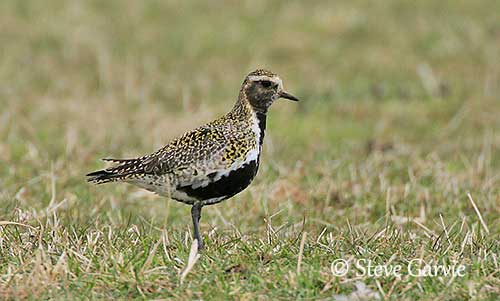
The breeding female has less black, with some brow markings below. She may have pale head sometimes.
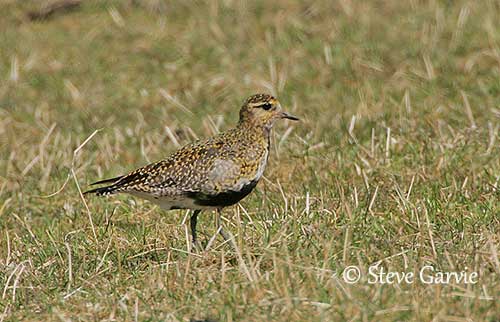
The non-breeding adult has plain golden brown upperparts, face and breast. On the underparts, the black is lost. Lower flanks and belly are whitish.
Male and female are similar.
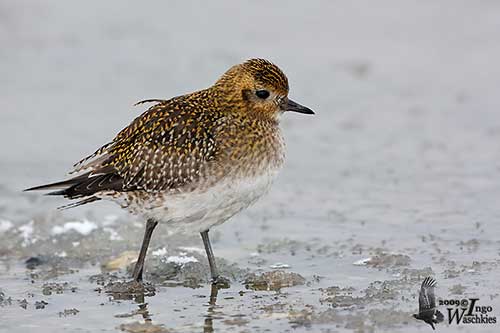
The juvenile resembles adult in winter, but it is slightly paler and duller. At close range, we can see fine dark bars on flanks, sparsely on belly.
SUBSPECIES AND RANGE:
The European Golden Plover has two subspecies.
P.a. altifrons (northern race) breeds in EC Greenland, Iceland and Faeroes to N Fennoscandia, E to Taymyr Peninsula.
In breeding plumage, the male is more uniformly black below and on the face. The breeding female has yellowish cheeks with black markings.
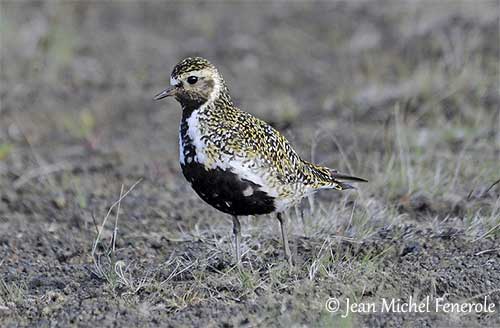
P.a. altifrons
Iceland
P.a. apricaria (southern race) breeds in N British Islands, through W Germany, Denmark and S Fennoscandia to Baltic States.
The European Golden Plover winters from British Islands, through Mediterranean to S Caspian Sea.
HABITAT:
The European Golden Plover usually prefers open grounds and tundra habitat. The nominate race breeds on highland heaths and moorlands, whereas the race “altifrons” breeds in more humid areas with moss and lichen, hummocks, shrubs and open bogs in forest or alpine tundra. It breeds up to 1200 metres of elevation.
At other times, on migration and during winter, they frequent short grassland, arable fields, saltmarsh and occasionally coastal mudflats where they can forage for food.
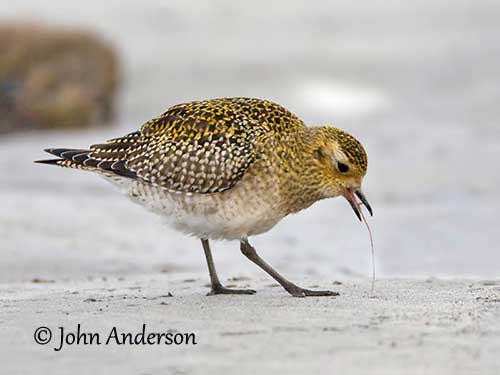
CALLS AND SONGS: SOUNDS BY XENO-CANTO
The European Golden Plover’s call is a mellow whistling “too-ee” or “tloo” often heard before the bird can be seen. During the flight display, it gives a repeated, melancholy piping “per-pee-oo…” also used as territorial song. It also gives a repeated, trilling “keroolya” in flight.
BEHAVIOUR IN THE WILD:
The European Golden Plover feeds primarily on invertebrates such as insects, earthworms, snails and crustaceans, and sometimes plant material including berries, seeds and grass. It takes insects and their larvae, spiders, millipedes and marine worms.
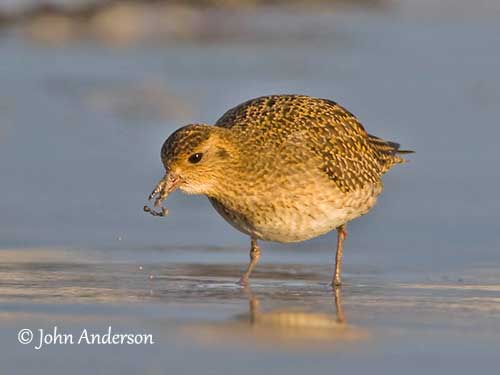
It forages on tundra, permanent grasslands, fields, beaches and tidal flats. It hunts usually by sight, but it also feeds by moonlight. It feeds typically in “run-pause-bob feeding action”. During winter, it is often accompanied by the Northern Lapwing.
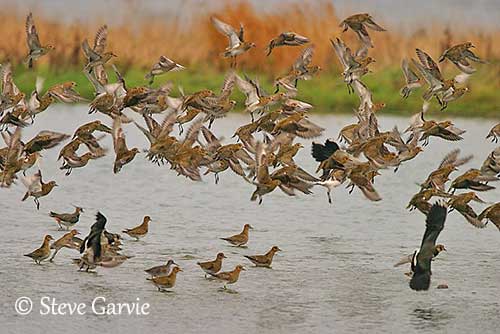
During the breeding season, the European Golden Plover performs aerial displays accompanied by song, a high, circling flight display, a butterfly-like action with almost horizontal, shallow wingbeats. It also flies slowly above its territory while calling.
The European Golden Plover is territorial. It breeds solitary with nests placed well apart. They are monogamous with long-term pair bonds. Nest density varies according to the range and the type of soil.
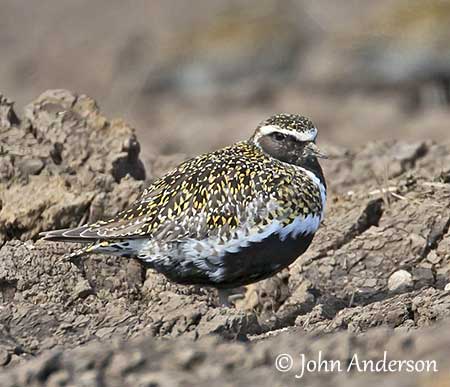
The European Golden Plover is migratory, although Britain and Ireland populations are only partially migratory.
This species is known for its cold spell-induced winter movements. The birds migrate from Scandinavia to spend the winter in NW Europe, but they may move again during winter to reach southernmost areas such as Iberia and Morocco.
These movements occur when the temperatures drop to freezing on the first winter area. However, they do not always move in response to freezing temperatures. Due to these winter movements, there is a great flexibility in migration patterns, involving a large spread in final wintering areas.
The European Golden Plover has rapid, direct, powerful flight with regular, rapid wingbeats.
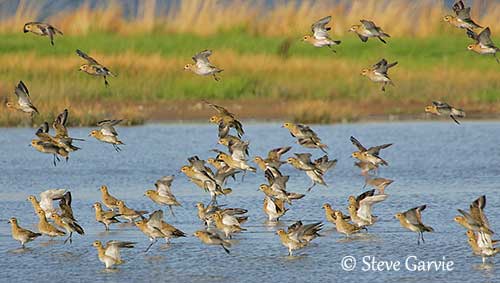
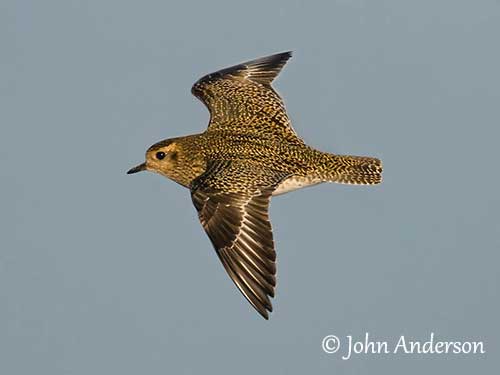
REPRODUCTION OF THIS SPECIES:
The breeding season takes place in spring, with the laying between late March and late July, according to the range.
The European Golden Plover nests solitary, with nests well-spaced (1-4 nests to 2-10 nests /km²). The density is decreasing in mountainous areas.
The nest is on the ground, in flat, open, vegetated areas, a shallow depression made by the male and lined with moss, leaves and stems.
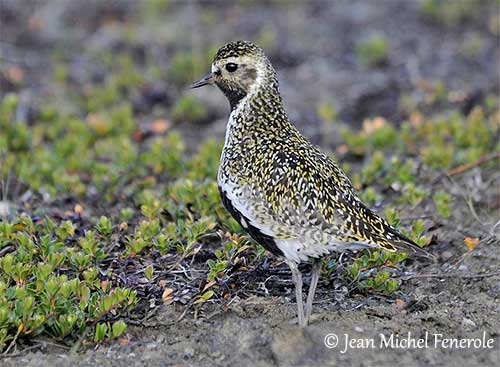
P.a. altifrons
Iceland
The female lays 3-4 olive eggs with dark markings. They are laid at intervals of 2-3 days. Both adults incubate during 27-31 days. At hatching, the chicks are mottled black and yellow above, with whitish underparts. They fledge 25-33 days after hatching (mostly 34-42 days in England). They are independent very soon and can breed at two years old.
The broods are vulnerable to predation by stoats (Mustela erminea) in NE England.
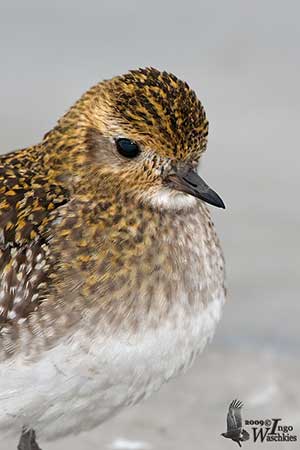
PROTECTION / THREATS / STATUS:
The European Golden Plover is vulnerable to very cold winter temperatures and severe weather conditions. It is frequently hunted on its wintering areas, and especially in France.
The breeding population of nominate race was estimated to number 1,800,000 individuals in 1994, but there is no available estimate of population of race “altifrons”.
The population is suspected to be declining, but currently, the European Golden Plover is evaluated as Least Concern.
